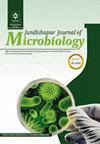Clostridium perfringens Spores in Urology Hospitals
IF 0.5
4区 医学
Q4 MICROBIOLOGY
引用次数: 1
Abstract
Background: Clostridium spp. spores are resistant to many factors, including alcohol-based disinfectants. The presence of clostridial spores in a hospital environment may lead to infection outbreaks among patients and health care workers. Objective: This study aimed to detect clostridial spores in aurology hospital using C diff Banana Broth™ and assess the antibiotic sensitivity and toxinotypes of isolates. Methods: After diagnosing COVID-19 in medical staff and closing an 86-bed urology hospital in 2020 for H2O2 fogging, 58 swabs from the hospital environment were inoculated to C diff Banana Broth™, incubated at 37°C for 14 days, checked daily, and positive broths were sub-cultured anaerobically for 48 h at 37°C. After identification, multiplex PCR (mPCR) was performed for Clostridium perfringens, C. difficile toxin genes, and MIC determination. Results: In this study, 16.58 (~ 28%) strains of Clostridium spp. were cultured: 11 - C. perfringens, 2 - C. baratii, and 1 each of C. paraputrificum, C. difficile, and C. clostridioforme. Moreover, C. difficile produced all toxins, and 11 C. perfringens consisted of 1 cpa, 7 cpb2, 2 cpiA, and 1 cpb gene-positive. All isolates were sensitive to metronidazole, vancomycin, moxifloxacin, penicillin/tazobactam, and rifampicin. Two out of the 11 C. perfringens strains were resistant to erythromycin and clindamycin. Conclusions: Regardless of the performed H2O2 fogging, antibiotic-resistant, toxigenic strains of C. perfringens (69%) obtained from the urology hospital environment were cultured using C diff Banana Broth™, indicating the need to develop the necessary sanitary and epidemiological procedures in this hospital.泌尿外科医院的产气荚膜梭菌孢子
背景:梭状芽孢杆菌孢子对许多因素具有抗性,包括酒精类消毒剂。医院环境中梭状芽孢的存在可能导致患者和卫生保健工作者之间的感染暴发。目的:应用C diff香蕉汤™检测泌尿科医院的梭菌孢子,并对分离菌株的抗生素敏感性和毒素类型进行评价。方法:在医护人员诊断出COVID-19并于2020年关闭一家拥有86个病床的泌尿科医院进行H2O2雾化后,将医院环境中的58份拭子接种于C diff Banana Broth™,在37°C孵育14 d,每天检查,阳性菌在37°C厌氧继代培养48 h。鉴定后,采用多重PCR (mPCR)检测产气荚膜梭菌、艰难梭菌毒素基因,MIC测定。结果:共培养出16.58株梭菌(约28%),其中产气荚膜梭菌11株,巴拉氏梭菌2株,副果状梭菌、艰难梭菌和梭状梭菌各1株。11株产气荚膜梭菌中有1株cpa、7株cpb2、2株cpiA和1株cpb基因阳性。所有分离株对甲硝唑、万古霉素、莫西沙星、青霉素/他唑巴坦和利福平敏感。11株产气荚膜荚膜球菌中有2株对红霉素和克林霉素耐药。结论:无论采用H2O2雾化,从泌尿科医院环境中获得的产气荚膜梭菌耐药毒株(69%)均使用C diff香蕉肉汤™进行培养,表明该院需要制定必要的卫生和流行病学程序。
本文章由计算机程序翻译,如有差异,请以英文原文为准。
求助全文
约1分钟内获得全文
求助全文
来源期刊

Jundishapur Journal of Microbiology
MICROBIOLOGY-
CiteScore
1.30
自引率
0.00%
发文量
56
审稿时长
6-12 weeks
期刊介绍:
Jundishapur Journal of Microbiology, (JJM) is the official scientific Monthly publication of Ahvaz Jundishapur University of Medical Sciences. JJM is dedicated to the publication of manuscripts on topics concerning all aspects of microbiology. The topics include medical, veterinary and environmental microbiology, molecular investigations and infectious diseases. Aspects of immunology and epidemiology of infectious diseases are also considered.
 求助内容:
求助内容: 应助结果提醒方式:
应助结果提醒方式:


